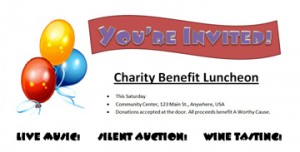You’ve had those days. The ones where the technology owns you so totally and completely that you’re ready to toss your computer out the window and live unplugged in a cave. Cue the printer scene from Office Space.
Creating content should not drive you to drink. It’s supposed to be fun. And useful. And help you get things accomplished.
If it’s not — if, after giving it your best shot, reading all the manuals, scouring the Web for advice — your company newsletter still resembles something your 3-year-old mashed out on the keyboard … Well, it might be time to call in the cavalry.
Us perfectionist types first need to determine whether we really need a lifeline or whether it’s just pride getting in the way. Think back on some of the examples we’ve discussed: the family Christmas letter, the birthday party invitation, the neighborhood newsletter. For these projects, the information is tons more important than the presentation. As long as you don’t accidentally leave out a basic bit of who, what, where or when, you’re good to go. Embrace your imperfection as “whimsical” and go on your merry way.
Business communications and big content projects are a different animal. That latter category would include your secret Great American Novel. Or the series of content-marketing articles meant to drive masses of Googlers to your website.
Rule of thumb: If you want your content to generate money for you — whether now or at some glorious point in the future — it needs to be done right. Sometimes, that means bringing in a professional. These are the grammar gurus who know the difference between active and passive voice, and why one is better than the other. They’re the ninjas who can fix the red eyes in your event photos. The code wizards who can turn your email campaign into interactive genius.
Fair warning, it’ll probably cost you some money. But think of it as an investment. If this project is really near and dear to your heart — or your bottom line — it’s worth the extra TLC.
“But wait,” you say, “in Commandment 4, you didn’t mention anything about hiring professionals. Have you seen what people are putting out there on the Internet? Why should I spend money when others clearly aren’t?”
Yep, I have seen what’s out there. It often makes me cringe. You, too, probably, or you wouldn’t have mentioned it. Imagine, then, the potential payoff if your communications painted you in a different, more professional light: a light that projects how much you care about your product and your customers.
Quality does matter. Make it your niche, your secret weapon, the thing that sets you apart from your riff-raff rivals.
Of course, you should also take a few precautions to get the best value:
- Use common sense when searching for a content professional. Those dollar-per-1,000-word-article offers on certain freelance boards are too good to be true, and you know it.
- Offer fair pay. You wouldn’t want your customers to ask you to charge one-quarter of your normal rate, so why ask it of any other professional? Get an idea of fair rates for common content projects from the Editorial Freelancers Association.
- Keep an open mind. Much like we discussed in Commandment 4, it can be scary to hand over your ideas to someone else. Ask for regular progress reports, and speak up if you don’t like where something is heading. But also be willing to admit that, yeah, maybe a rainbow unicorn theme doesn’t work particularly well for your sofa-sale ad.


